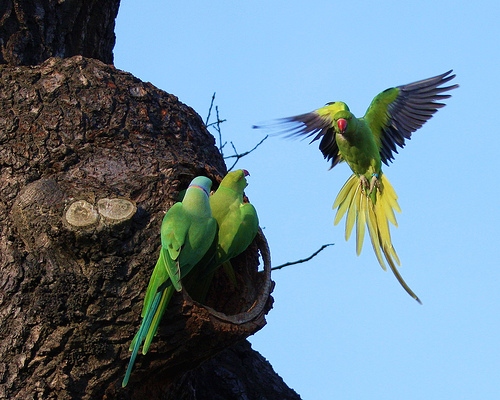Pesky parakeets pay the price
 Locals and especially those who visit the park will be familiar with the striking sight and sound of the green ‘ring-necked’ parakeets that inhabit the area. There are thought to be 45,000 of these in the UK with 90% of these in London, mainly concentrated in the South West.
Locals and especially those who visit the park will be familiar with the striking sight and sound of the green ‘ring-necked’ parakeets that inhabit the area. There are thought to be 45,000 of these in the UK with 90% of these in London, mainly concentrated in the South West.
Due to issues such as attacks on smaller birds, crops and other plants as well as general health and safety from droppings, caused by their growing numbers (30% increase each year) they will soon have the same legal status as pigeons, crows and magpies. From January 2010, it will be legal to capture, kill or destroy the eggs of this species which might sound strange considering it is still a protected one.
Currently anyone who needs to control the bird numbers through shooting must apply for a license – the new ruling will circumvent this. One example of how destructive they can be when feeding whilst in flocks is a farm in Cobham, Surry which lost 3,000 bottles-worth of grapes in one day. As they are originally from the Himalayas, these and other non-native species need to be carefully monitored in numbers and impact on the environment.

Photo: Parakeets in Bushy Park by miacat63
The RSPB and other associations however are keen to point out that this means land owners and councils should only consider this method as a last resort and will be allowed to kill the birds only if they can demonstrate a legal reason for needing to do so – members of the public won’t be able to simply practice this in a public space such as Bushy or Richmond Park and this ruling shouldn’t be seen as a green-light for a general cull.
There are various theories about where the green guests came to settle around London ranging from an escape from cargo at Heathrow, Jimi Hendrix releasing a pair into the wild in the 60’s and the most popular is that some escaped from Shepperton Film Studios in the 50’s during filming of “The African Queen”. Despite being very noticeable now however, it’s much more likely that they have been in Britain since early recordings as far back as 1855 and growing in numbers ever since, with numbers picking up pace especially since the 30’s and increasing wild breeding from the 70’s.


